
WWW.PATTAYAMAIL.COM
The Thai-Cambodia border disputes: the case for Thailand
An armed soldier guards the Preah Vihear temple complex, a UNESCO world heritage site.
All senior Thai politicians, with or without Paetongtarn Shinawatra in the driving seat, are adamant that they will not debate the Cambodian border disputes at the International Court of Justice (ICJ) in the Netherlands. Cambodia will seek a favorable judgment alone on several ancient temples and surrounding land in north east Thailand known as the Emerald Triangle.
Although the ICJ was set up by the United Nations in 1946 with 15 nominally independent judges, its record is sketchy to say the least. The US withdrew from being bound by its findings as early as 1986 (human rights in the war in Nicaragua) and Iran refused a judgment against itself in 1979 (the US hostages crisis). Australia declared in 2002 that it would not be bound by decisions about maritime boundaries.
In the last two years, Israel has rejected arbitration about genocide in Gaza, whilst Russia has denied violating the genocide convention of 1948. There are many more examples. In 1962 the ICJ awarded the Preah Vihear temple to Cambodia without clarifying ownership of the surrounding territory. Critics say that decision is typical of ICJ decisions which rely on judicial diktats without resolving the underlying disputes.
The confusion, of course, is the fault of France which formerly ruled Cambodia. In 1904 a French treaty signed with Siam decided the Dangrek Mountains to be the natural watershed barrier creating the borders. The treaty thus placed the disputed Preah Vihear complex in Thailand, although the exact demarcation was left to a mixed commission which never reached a conclusion. A further treaty of 2007, drawn up by French surveyors with little Siamese input, deviated from the natural boundary of the mountains and placed the temple in Cambodia’s orbit. Thailand later contested that amid arguments over which maps were reliable.
The International Court of Justice in The Hague lacks enforcement powers and all governments know it.
Thus Thailand rejects reliance on colonial cartography 120 years old to prove contemporary geopolitics. Still the ambiguity led the ICJ in 1962, generously confirmed in 2012, to support Cambodia’s claims largely on the grounds that Siam’s leaders at the time had – de facto – accepted the 1907 demarcation, only to complain later. The 1962 judgment was a split decision: 9 to 3 in favour of Phnom Penh. Thailand had given notice beforehand she would not accept foreign ownership of Thai territory based on disputed maps.
Whilst Cambodia certainly views the clutch of temples and adjoining land as a proud national heritage and a symbol of sovereignty, the same is true of Thailand. Both nations are currently in a frenzy of intense patriotism. Obviously Phnom Penh will seek to refer the issues to historically-friendly international arbitration, even though there is no realistic mechanism or political will to force agreement. Pie in the sky is an appropriate summary.
In 2000, Cambodia and Thailand agreed to set up the two-country Joint Boundary Commission to resolve border disputes. It last met in June 2025 and unsurprisingly failed to make any progress. But it is just as capable as the ICJ in boundary demarcation , including the use of LiDAR technology to orthophoto maps. The best way forward is likely dual discussions under ASEAN auspices. Joint sovereignty of some border areas and treasured ancient temples offers the best chance of resolution. Borders are fickle entities at the best of times. Thailand controlled Siem Reap and its temples from 1795 to 1907 and the ownership dispute dragged on until the end of world war two. Cool head not rhetoric are needed once again.
0 hisse senetleri
11 Views



